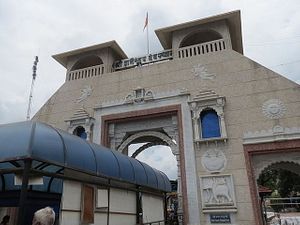Shani is a god that Hindus fear, not love. Usually depicted as black-skinned and riding a crow, Shani is associated with the inauspicious planet Saturn. Not one of the main personae of the diverse Hindu pantheon, Shani is not so often worshipped but is the god to which many Hindus turn when dealing with great misfortunes. Shani might also be considered fairly conservative, as one of his famous temples, the Shani Shinghnapur in a rural area of the Maharashtra state, until recently did not accept women in its sanctum sanctorum.
The various entry restrictions that had been (and sometimes still are) in force in various sacred places of India tell a lot about social hierarchies and divides. Women are still not admitted to a few Hindu temples, and to a number of Muslim holy places. Many Hindu temples would not let inside any non-Hindu and the Dalits (untouchables), the pariahs of Hindu societies. (Even some Christian churches did not admit lower-caste Christians to parts of the premises.) Such strict rules, based on the assumption that non-Hindus and untouchables are impure, were largely discontinued in the 20th century in wake of Gandhian campaigns and government orders and pressures.
There are also bans linked more to particular customs and beliefs. Some Hindu temples do not accept women clad in Western attire, but there are also a few ones that force men to come in without shirts (for example in Gokarn in Karnataka). The Hindu holy places would also traditionally not allow women to enter during their menses, when the fairer sex is considered to be temporarily impure. In some cases, regional myths can also explain why it is the men, rather than women, who cannot enter places of worship of certain goddesses. That is the case Kamakhya temple in Vishakhapatnam, where the goddess is depicted and worshipped in her menstruating form.
As for the Shani Shinghnapur temple, the reported explanation is that Shani’s power would adversely influence women should they come near the main altar. This power somehow does not affect men. During the recent controversy about women trying to enter this holy place, one important Hindu religious leader, Swaroopanand Saraswati even tried to base this belief on the current concerns with crimes, claiming that allowing the fairer sex inside the temple would lead to a rising number of rapes (as a realization of Shani’s powers). Not surprisingly, his remark drew heavy criticism.
It is also interesting to note who started the struggle. It was not some Leftist or outspokenly atheist organization that called on the temple to open its doors, using rhetoric couched in secular terms. Rather, the body that started the movement in 2015 is called Bhumata Ranragini Brigade. This is the women’s wing of Bhumata Brigade, an organization that deals with various social vices, especially those concerning women. The leader of the wing is Trupti Desai, who provoked controversy by trying to enter the temple premises twice in 2015, with a number of Brigade members. She was stopped on both occasions, but attracted the media attention she sought. Desai makes no secret of the fact that she is a believing Hindu and that she was striving to achieve her goals, not against religion but because of it. “Women of every religion should be allowed to go to religious places of their respective faiths. People who consider women as impure should realize that they have come into existence only because of women. Even the milk that is poured [as offering] on the shrines inside temples is from cows and buffalos, which are also female,” she said.
Cases such as this are always interesting, as they point out that within a religious tradition there may be a group somehow castigated or stigmatized, and yet, while some members of this group may turn away from this religion, others may still strive to follow it. Christian homosexual organizations may be another example of this process. The Shani temple’s story also shows that within Hindu traditions there is a place for both people such as Trupti Desai and the likes of Swaroopanand Saraswati.
Desai’s position of a woman devotee made it more difficult for temple authorities and other, less conservative Hindu organizations to oppose her. The Organiser, the mouthpiece of the RSS, a Hindu nationalist organization linked to the present Indian government (both the central one and the one in the state of Maharashtra, where the temple is placed), reacted to the Shani temple controversy in a rather mild manner, opposing the Brigade’s methods rather than its claims. Indicating that it may be open to a change in rules, the Organiser expressed an opinion that any such debate should be solved through a debate within a religious tradition, rather than by force or government interference.
But the latter could have been looming large as well and the brigade knew that the law was on their side. The Indian constitution on the one hand promises that the state will not interfere in religious affairs, but on the other it guarantees equal treatment for all of its citizens, including the equal right to worship. Since, as mentioned at the beginning of this text, the traditional rights of worship are uneven, these two basic rules of the secular Indian state often cannot be reconciled. For example, the Untouchability (Offenses) Act that had been voted into law back in 1955 forces all Hindu temples to open their doors to untouchables. The result was that some small religious communities preferred to be recognized as different from Hindus rather than change their orthodox ways. Similarly, the courts have usually spoken in support of women’s access to temples.
Eventually, on April 8 this year, the Shani Shinghnapur temple authorities gave in to the pressure and decided to begin accepting women in the inner sanctum. The successful brigade may now set its sight on other temples that bar the fairer sex, such as the temple of goddess Lakshmi in Nasik or the Triambakeshwar temple near the same city.

































